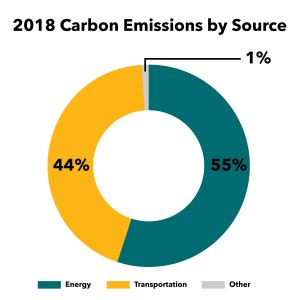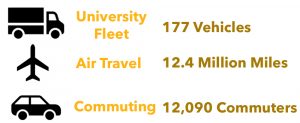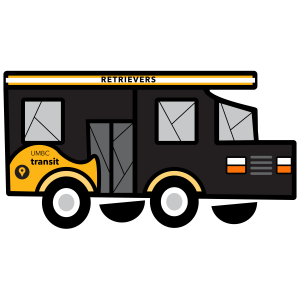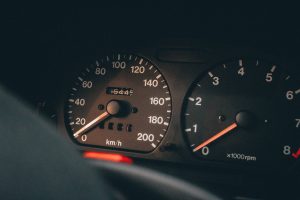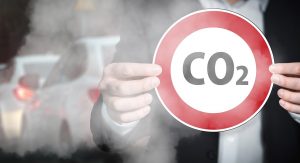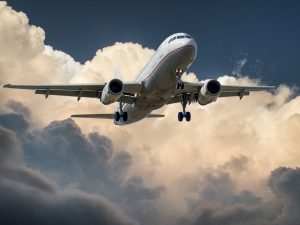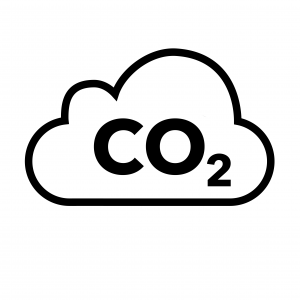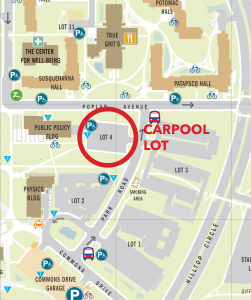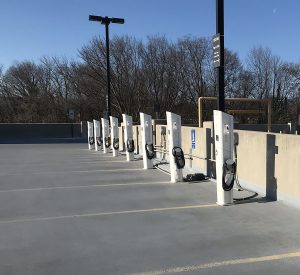GHG emissions from transportation arise from burning fossil fuel primarily for cars, trucks, buses, and commercial aircraft. Transportation generated over 44% of UMBC’s GHG emissions, making it the second leading contributor to the university’s GHG emissions.
In FY 2018, UMBC generated an estimated 27,020 metric tons of carbon dioxide equivalent (MTeCO2) from transportation sources. The largest contributor to these GHG emissions at 68% was commuting by faculty, staff, and students. Air travel contributed another 30%. The university fleet contributed less than 3% of transportation’s GHG emissions.
Over the last ten years, UMBC has reduced eCO2 contributions from transportation by 6% primarily through a reduction in sanctioned air travel, expansion of UMBC’s transit system, and upgrades to cleaner, higher-efficiency cars, buses, and other vehicles. Additional measures focused on bicycling, car and ride-sharing, and EV charging stations.
Achieving further reductions in GHG emissions from transportation is possible by focusing on increasing the efficiency of vehicles, changing how and when we travel and purchasing carbon offsets for unavoidable greenhouse gas emissions.
University Fleet
While the 177 gas- and diesel-powered vehicles within the university fleet contribute less than three percent of transportation’s GHG emissions, its composition, use, and practices are completely in the control of the university. UMBC’s plan for carbon neutrality is to move forward with these readily implementable strategies.
- Reduce the number of miles traveled.
- Lease or purchase more energy-efficient vehicles and dispose of old vehicles that they are replacing.
- Reduce or eliminate vehicle idling.
- Purchase carbon offsets.
Air Travel
Nearly 12.4 million miles of air travel in FY 2018 were completed by faculty, staff, and students in the conduct of their business or management of programs. While fuel efficiency of commercial fleets and future potential for reduced emissions from planes are not within UMBC’s control, UMBC’s plan for carbon neutrality is to eliminate the impact of university-related air travel on carbon emissions with these planned strategies.
- Replace air travel with virtual meetings to reduce the number of trips.
- Replace air travel with lower-emitting travel alternatives.
- Explore the feasibility of a flight surcharge to purchase carbon offsets.
Commuting
In FY 2018, UMBC’s 12,090 commuters contributed nearly 20,850 metric tons of carbon dioxide equivalent (MTeCO2) traveling to and from campus, mostly in single occupancy gas- and diesel-powered vehicles. UMBC’s plan for achieving future carbon neutrality targets these measures to eliminate commuting’s contribution to emissions.
- Promote commuting alternatives to reduce reliance on single-occupancy vehicles.
- Provide sustainable mobility options for residential students.
- Incentivize the use of fuel-efficient personal vehicles.
- Reduce the number of required trips per week by faculty, staff, and students.
- Purchase carbon offsets.
Progress
UMBC has made advances over the last ten years to reduce the total amount of GHG emissions attributed to transportation by improving the efficiency of our fleet, providing transportation alternatives, and encouraging behavior change. Between FY 2007 and FY 2019, the university reduced its MTeCO2 contributions from transportation by 4.2% from 28,199 metric tons to 27,019 metric tons, while supporting an increase in student enrollment of over 10%.
The top three achievements contributing to these measurable reductions in GHG emissions were:
- Reduction in sanctioned air travel;
- Expansion of our transit system to seven routes carrying up to 1,200 riders each day; and
- Upgrades to cleaner, higher-efficiency cars, buses, and other vehicles.
Additional measures were put in place to promote less reliance on the use of low-efficiency single-occupancy vehicles.
- Installation of bicycle parking facilities and fix-it stations to encourage student bicycling and commuter cycling;
- Implementation of a ride-sharing program and preferred parking spaces for carpoolers;
- Installation of two electric vehicle charging stations; and
- Smaller more efficient shuttle buses.
Future Steps
Achieving reductions in GHG emissions from transportation requires a three-prong approach to increasing the efficiency of vehicles, changing how we travel, and using lower-carbon fuels. UMBC’s proposed various strategies for reducing GHG emissions are targeted at three principal areas: university fleet, air travel, and commuting.
University Fleet
The current fleet of vehicles used by 19 departments across five university divisions totals 211 and includes a wide range of vehicle types. UMBC leases ten buses and two construction vehicles, leaving 199 vehicles owned and operated by the university. Of these, 177 vehicles are gas- or diesel-powered cars, passenger vans, trucks, buses, and utility/equipment vehicles with an average age of 10 years. While the university fleet contributes less than three percent of transportation’s GHG emissions, its composition, use, and practices are completely in the control of the university. As such, there are readily implementable opportunities to improve our carbon footprint by focusing on campus-related vehicle usage.
Four strategies are proposed that have the potential to reduce greenhouse emissions generated by the gas- and diesel-powered vehicles within the university fleet.
- Reduce the number of miles traveled.
- Replace existing vehicles with electric, higher fuel efficiency, or plug-in hybrid vehicles.
- Reduce or eliminate vehicle idling.
- Purchase carbon offsets.
Mileage Reduction
Objective: Reduce emissions through a targeted reduction in the number of miles traveled by personnel using the university fleet’s gas- and diesel-powered vehicles.
Implementation Plan:
- Improve operational efficiency by consolidating trips and strategically planning routes to reduce miles traveled.
- Provide alternative transportation modes for on- and off-campus travel.
- Dispose of excess gas-powered and/or diesel-powered vehicles.
Reduction Opportunity:
- For every 100 miles of travel avoided approximately 1 MTeCO2 is avoided per vehicle. For every gas-powered vehicle that is eliminated from the university fleet, ~63 MTeCO2 is avoided. For every diesel-powered campus vehicle that is eliminated from the university fleet,~360 MTeCO2 is avoided.
Required Resources:
- Central database to record and analyze trip data to determine a baseline and track progress to reduce emissions.
- $ per year for bicycles or low-speed electric vehicles for on-campus travel
- $ per year for ride-hailing or ride-sharing services for off-campus travel
Timeline:
- 6 months after initiative launch – develop trip log database to collect miles traveled per vehicle and unit
- 12 months – review and analyze trip log data by vehicle and unit
- 16 months – complete operational review to identify opportunities for reducing mileage
- 20 months – implement operational changes, and provide alternative on-campus and off-campus travel modes
- 32 months – review and analyze trip log data by vehicle and unit; assess impact of operational changes, and develop a proposal for a phased reduction in the fleet
- 36 months – dispose of select vehicles without replacement
- Annually thereafter – repeat steps outlined at 32 and 36 months
Vehicle Replacement
Objective: Reduce emissions through targeted replacement of gas- and diesel-powered, university-owned vehicles with higher efficiency vehicles.
Implementation Plan:
- Replace the 78 vehicles over 10 years old with higher efficiency vehicles including hybrid and/or electric vehicles.
- Install additional dedicated power stations as needed to charge a growing fleet of electric service vehicles.
Reduction Opportunity:
For every gas-powered or diesel-powered campus vehicle that is replaced by a more energy-efficient and cleaner running vehicle, 60 to 360 MTeCO2 is avoided.
Required Resources:
- Central database to record fuel efficiency, age, and type of each vehicle in the university fleet to determine a baseline and track progress to reduce emissions.
- $ per year for the cost of replacement vehicles
- $ per year for ride-hailing or ride-sharing services for off-campus travel
Timeline:
- 3 months after initiative launch – develop vehicle database; and complete survey and assessment of fleet
- 6 months – develop a proposal for the phased replacement of select vehicles factoring in cost and impact to operations
- 9 months – lease or purchase more energy-efficient vehicles and dispose of old vehicles that they are replacing
- Annually thereafter – reassess fleet, cost, and operational needs; lease or purchase more energy-efficient vehicles, and dispose of old vehicles
Fuel Waste Reduction
Objective: Reduce emissions from unnecessary idling of the university fleet’s gas- and diesel-powered vehicles.
Implementation Plan:
- Install idle-time tracking on vehicles operated by Facilities Management, UMBC Transit, UMBC Police, Residential Life, and Parking Services.
- Develop and implement idling policies for campus users, contract personnel, and delivery personnel.
Reduction Opportunity:
For every gas-powered or diesel-powered campus vehicle that is turned off when not in use, a yet undetermined amount of MTeCO2 is avoided.
Required Resources:
- Central database to record fuel usage for each vehicle to determine a baseline and track progress to reduce emissions.
- $ per year for idle-time tracking equipment
Timeline:
- 3 months after initiative launch – specify idle-time tracking equipment and the vehicles which would be equipped with the equipment
- 6 months – purchase and install equipment on an initial set of vehicles, and develop a database to record fuel usage for each vehicle
- 12 months – analyze results of six months of use; review findings with vehicle operators to understand reasons for idling.
- 18 months – develop and implement idling policies for campus users, contract personnel, and delivery personnel; establishing monitoring processes; and train personnel
- Annually thereafter – analyze and review idling data; and train personnel
Air Travel
Air travel encompasses all trips purchased by departments and centers on behalf of faculty, staff, and students in the conduct of their business or management of programs. In FY 2019, 160 campus units logged over 12,300,000 miles of air travel and contributed 30 percent of the university’s transportation-related GHG emissions. Among the 160 units that funded air travel, 13 academic units logged roughly 50% of all miles traveled.
While fuel efficiency of commercial fleets and future potential for reduced emissions from planes are not within the university’s control, the impact of university-related air travel on carbon emissions can be minimized by focusing on reducing the number of trips, using transportation modes with fewer emissions, and by purchasing carbon offsets.
Three strategies are proposed that have the potential to reduce GHG emissions generated by air travel.
- Replace air travel with virtual meetings.
- Replace air travel with lower-emitting travel alternatives.
- Explore instituting a flight surcharge to purchase carbon offsets.
Successful implementation of the first two strategies would be unlikely to reduce air travel significantly much less yield carbon neutrality. However, the flight surcharge program could be implemented at any time to achieve immediate carbon neutrality for air travel.
Virtual Meetings
Objective: Reduce emissions through increased use of web-based meetings to replace the need for air travel.
Implementation Plan: Provide faculty, staff, and students access to web-based meeting platforms to facilitate remote participation in meetings.
Reduction Opportunity:
For every 100 miles by air eliminated, 4.2 MTeCO2 is avoided.
Timeline:
- 9 months after initiative launch – develop database; and launch an advertising campaign with instructions on the use of web-based platforms for virtual meetings
- 21 months – analyze trip and web-based meeting data
- Annually thereafter – track use of web-based meeting participation to calculate emissions savings
Travel Alternatives
Objective: Reduce emissions by encouraging greener transportation alternatives, like train or fuel-efficient car travel, in lieu of airplane travel for regional trips.
Implementation Plan:
Encourage travel options other than air travel for regional trips.
Reduction Opportunity:
- For every 100 miles by air replaced by bus travel, 3.2 MTeCO2 is avoided.
- For every 100 miles by air replaced by train travel, 1.5 MTeCO2 is avoided.
- For each mile by air replaced by fuel-efficient hybrid vehicle travel, 1.3 MTeCO2 is avoided.
Required Resources:
- Central database to record trip data and mode of travel to determine a baseline and track progress in emissions reduction.
- $ for advertising campaigns and incentives.
Timeline:
- 9 months after the initiative launched – develop database; and launch an advertising campaign to encourage train or car travel for regional trips.
- 21 months – analyze trip and mode data
- Annually thereafter – analyze data and calculate emissions savings
Carbon Offsets
Objective: Reduce emissions contributed by air travel through the application of flight surcharges to fund the purchase of carbon offsets.
Implementation Plan:
Establish a flight surcharge program to purchase carbon offsets equal to emissions generated by each mile of air travel.
Reduction Opportunity:
100% of emissions*
Required Resources:
- Central database to record all data necessary to calculate emissions from air travel.
- Business process to collect flight surcharges.
- $ for every air mile traveled to purchase carbon offsets.
*Note: A 100% goal in the reduction of GHG emissions generated by university air travel could be achieved immediately through the purchase of carbon offsets costing between $40,000 and $50,000.
Timeline:
- 6 months after initiative launch – create air travel database; create flight surcharge business process; and advertise the change
- Annually thereafter – purchase offsets, and assess the cost of offsets and adjust the surcharge
Commuting
UMBC is located in south Baltimore County along the I-95 corridor between Baltimore and Washington. Established in 1966 as a commuter school, the university has evolved into a research-intensive and highly residential campus. The ease of access to both I-95 via I-195 and the Baltimore Beltway (I-695) via Wilkens Avenue, as well as the low-density suburban development around the campus, has fostered a continued reliance on single-occupancy vehicles for faculty, staff, and commuting students. Commuting contributes 68 percent of transportation’s GHG emissions and 30 percent of total campus GHG emissions.
The university has three principal groups who travel to and from campus in single-occupancy gas- or diesel-powered vehicles: faculty and staff, commuting students, and residential students.
For Fall 2018, UMBC had a campus community of over 16,000 people of which 25% lived on campus. On any weekday, as many as 12,090 people could have been traveling to and from campus. For this period of time, permits were issued to 1,838 faculty and staff and 8,380 permits were issued to students to park personal vehicles on campus.
Faculty, staff, and non-residential students would have made numerous trips to and from campus each week and contributed the bulk of the emissions from single-occupancy gas- or diesel-powered vehicles. While the 3,979 undergraduate students living on campus in fall 2018 would have had a lower impact on the university’s carbon footprint, they potentially would have traveled off-campus for jobs, recreation and shopping, and visiting parents or other family members.
Four strategies with the potential to reduce GHG emissions generated by reliance upon the use of single-occupancy gas- and diesel-powered vehicles for commuting by the campus community include:
- Promote commuting alternatives to reduce the number of single-occupancy vehicles.
- Improve the fuel efficiency of personal vehicles.
- Reduce the number of trips per week.
- Purchase carbon offsets.
UMBC continues to make progress in promoting alternative modes of transportation and encouraging the use of electric vehicles. Trip reduction has the potential to significantly reduce emissions. Continued implementation of the first three strategies will likely reduce commuting in single-occupancy gas- and diesel-powered vehicles but not eliminate commuting’s contribution to GHG emissions. Carbon offsets will be required to achieve carbon neutrality from commuting.
Commuting Alternatives
Objective: Reduce emissions by promoting and facilitating alternatives to driving single-occupancy vehicles.
Implementation Plan:
- Develop enhanced transportation alternatives including public transportation (rail and bus), UMBC transit, carpooling, bicycling, and walking by:
- Providing or facilitating transportation between MTA and MARC stations to the campus.
- Expanding UMBC transit service to currently underserved populations.
- Developing a robust carpool program.
- Coordinating with regional communities and county agencies to improve the walking and bicycling paths to and from campus.
- Promote commuting alternatives by:
- Advertising programs and create incentives, games, and competitions
- Developing an app/info page on how to connect from campus to MTA buses, MARC trains, Light Rail, Metro, etc. to facilitate inter-modality of transit types and expand the catchment area
- Reaching out to all faculty and staff that are near transit routes to educate and change the commuting culture
- Advertising the use of Zimride or other rideshare apps geared to university users to encourage carpooling
- Allowing flexible parking passes and shared parking permits
- Making commuter biking a more visible alternative through the annual “UMBC Bike Party” and Bike to Work Day incentives.
- Providing a limited number of free “guaranteed rides home” passes for bicycle commuters for bad weather, emergencies.
- Applying for State grants for regional bicycle improvements.
- Continued campus support for vehicle sharing programs, like ZipCar, for getting off campus and to regional services and events
- Create disincentives to driving single-occupancy vehicles to campus by raising the cost of parking permits.
- Eliminate parking for residential freshmen and sophomores by:
- Providing unlimited ZipCar use
- Expanding UMBC Transit service to underserved areas for weekend travel
- Expanding and promoting rideshare programs, like Zimride, for getting home on weekends and holidays
- Provide sustainable mobility options for residential students that allow them to get to class, recreate, and attend cultural events, entertainment, dining, and services in the adjoining communities without the need for a car.
Reduction Opportunity:
For each single-occupancy gas- or diesel-powered vehicle that does not travel to and from campus X amount MTeCO2 is avoided (variable based on make, model, the fuel efficiency of the vehicle).
Required Resources:
- Staff to coordinate initiatives and prepare grants, document successes, etc.
- Analysis of where faculty and staff live to target promotion of walking, cycling or transit depending upon the distance from campus.
- Funds for promotional materials
- Investment in facilities including:
- Carpool lot
- Bike Fix-It stations
- Bike paths and lanes
- Shared use paths for cyclists and pedestrians
- Connecting pathways to Arbutus and other county partners
Timeline:
- 6 months after the initiative launched – submit a detailed strategy to promote alternative modes of transportation
- 9 months –launch an advertising campaign, and provide 5-year plan of physical improvements
- 12 months – implement initiatives, incentives, grant proposals, etc.
- Annually thereafter – reassess the success of initiatives; launch additional initiatives, and estimate single-occupancy trips eliminated to calculate emissions savings.
Improved Fuel-Efficiency
Objective: Reduce emissions through increased use of electric and plug-in hybrid vehicles for commuting.
Implementation Plan:
- Expand the EV charging network in locations that promote use.
- Provide free charging of personal vehicles.
- Develop a marketing strategy to highlight this expanded network.
Reduction Opportunity:
For each gas- or diesel-powered personal vehicle that is replaced by an electric vehicle X amount MTeCO2 is avoided (variable based on make, model, the fuel efficiency of the vehicle).
Required Resources:
- $ for every new EV charging station
- $ for marketing
- Usage data from EV charging station vendor
Timeline:
- On-going – Installation of 17 additional EV stations will be completed by May 2020
- 6 months after installation of new EV stations – assess utilization
- Annually thereafter – assess use; calculate emissions savings of plug-in vehicles; and assess the need for additional EV stations
Trip Reduction
Trip Reduction
Objective: Reduce emissions by providing opportunities to work and study at home.
Implementation Plan:
- Promote and support teleworking for those positions and functions for which working from home or at a satellite location is appropriate.
- Promote and support compressed work weeks for those positions and functions for which working more hours each day for fewer days is appropriate.
- Expand hybrid and on-line only courses.
- Encourage residential students to remain on campus on weekends with vibrant student life initiatives.
Reduction Opportunity:
For each eliminated trip, X MTeCO2 is avoided.
Required Resources:
- Database to record telework agreements including miles per week avoided.
- Personnel to manage the program
Timeline:
- 6 months after initiative launch – release an application to record telework agreements including miles per week avoided, and advertise the program
- Annually thereafter – assess telework and on-line course data, and calculate emissions savings
Carbon Offsets
Objective: Reduce emissions contributed by commuting through the application of parking permit surcharges to fund the purchase of carbon offsets.
Implementation Plan:
Establish a parking surcharge program to purchase carbon offsets equal to emissions generated by personal gas- and diesel-powered vehicles.
Reduction Opportunity:
100% of emissions
Required Resources:
- Central database to record all data necessary to calculate emissions from personal vehicles.
- Business process to collect surcharges.
- $ for every commuting mile traveled to purchase carbon offsets.
Timeline:
- 6 months after initiative launch – create a travel database; create carbon emissions surcharge business process; and advertise the change
- Annually thereafter – purchase offsets, and assess the cost of offsets and adjust the surcharge
